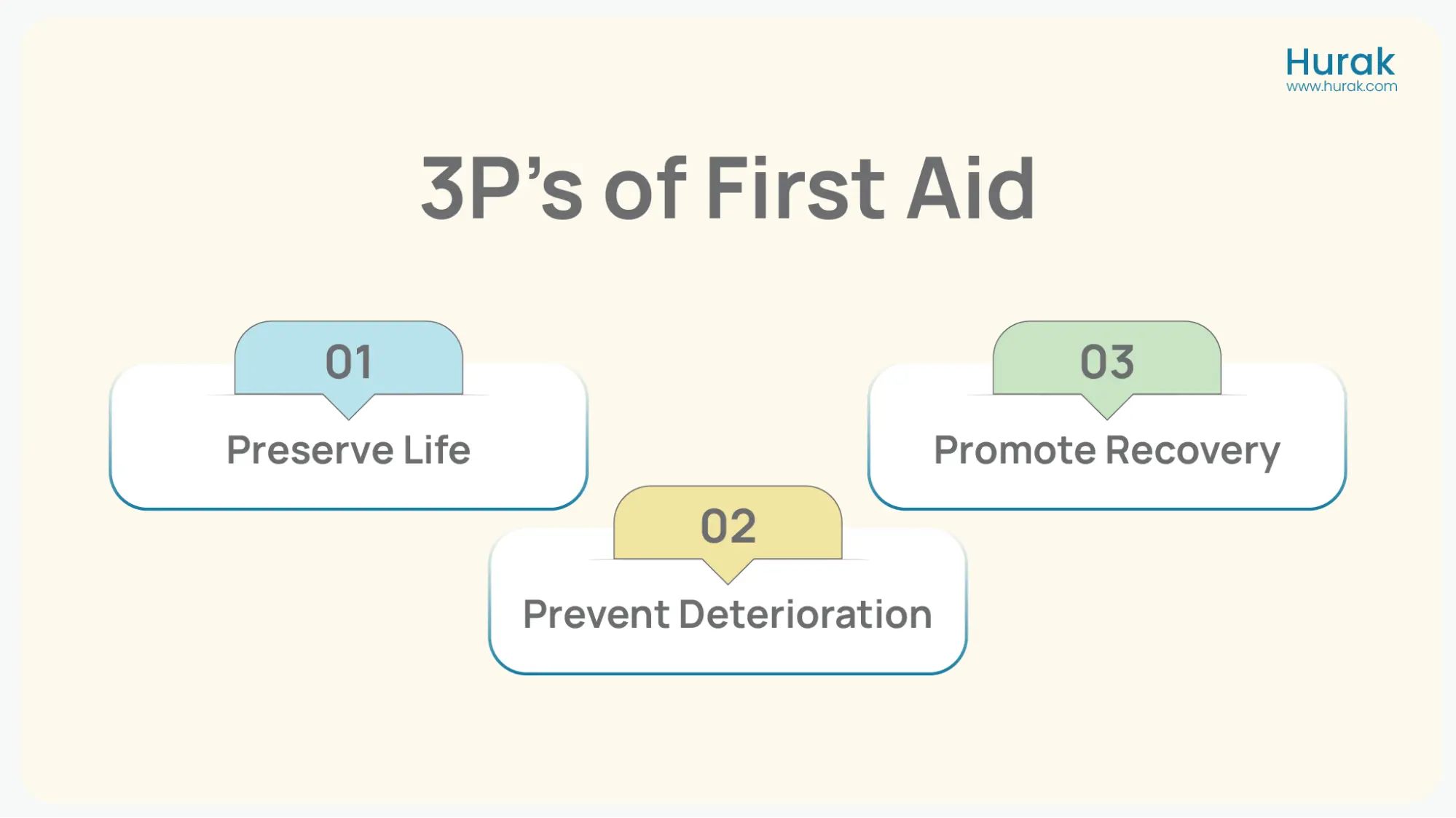Imagine being in a situation where an accident or a medical emergency occurs, instead of panicking and wondering what to do you can efficiently manage the situation by familiarising yourself with the 3 P’s of first aid. Let’s have a close look at the three P’s of first aid and understand how they can be helpful when faced with an emergency.
What are the 3 P’s in first aid?
The 3 P’s of First aid stands for Preserve Life, Prevent Deterioration and Promote Recovery. Familiarising yourself with the 3 P’s is arguably the most useful knowledge a first aider can equip themselves with, The primary aim of these techniques is to prevent serious injuries, and provide first aid. Let’s take a closer look at each of the 3 P’s

Preserve Life: The First Step to Safety
The optimal solution to handling an emergency is to have prevention measures in place so the likelihood of an accident is exponentially minimised. By implementing the first step, you are essentially creating a safer environment. Below you will find some key points that will help you understand the importance of the principles of first aid:
Awareness: Scan and take in your surroundings. Being vigilant and aware of potential hazards can be helpful, for instance if someone is having an allergic reaction and the presence of mold is prevalent in the area that might help you understand the cause, understanding the cause inadvertently helps in knowing what needs to be done, Another example of potential hazards could be exposed wires) being vigilant can be efficacious in preventing emergencies, irrespective of the location, whether you’re at home, out camping or at work.
Being well informed: Educate yourself about the risks that you are most likely to encounter within your surroundings. A prime example would be knowing how to give CPR or control excessive bleeding. With the right information and if implemented accurately, it can control a situation before the damage is done.
Ready to take action: You need to have the basic first aid supplies with you, and these supplies should be easily accessible. A first aid kit that has everything a first aider could need in an emergency can save lives during an emergency.
Prevent Deterioration
The steps below will be invaluable for a first-aider in an emergency.
Carefully evaluate the environment: Before you approach the victim, examine the environment for any hazards like oncoming traffic, loose cables or a building that is not stable.
· Familiarise yourself and implement the ABC Of first aid:
A (Airway): Check if the airway is clear. If not, it may need to be opened. Quickly assess if the airway is blocked, and if it is, take the appropriate steps to remove the blockage so that air can flow freely.
B (Breathing): Observe the movement of the chest and notice if it is moving while listening closely for the sound of breathing, even if it’s faint.
C (Circulation): While checking the airway and breathing do not waste any time and check the pulse, if there is no pulse start performing CPR.
You may often find yourself in a helpless situation despite being a trained first aider. The optimal solution is to call emergency services, provide them with clear and concise information about the steps you took, and let them handle the situation.

How To Administer CPR ?
Don’t wait until an emergency strikes! Understand the 3 principles of first aid, our basic first aid course breaks down how the 3 principles can efficiently manage a difficult situation related. Get certified today and save lives.
Promote Recovery:
- Appropriate measures: The initial step is to act quickly and do what you deem best to control the emergency. The aim is to ensure the person’s condition doesn’t get worse.
- Don’t Panic: Your demeanour can have a direct impact on the mental state of the victim, so it is absolutely necessary that you remain calm, speak in a reassuring manner.
- Documentation: once the person is stable, start documenting the incident and your steps. This information can be critical for emergency responders when they arrive.
The third and last step is the three P’s in promoting recovery; once you’ve stabilised the hazardous situation, it is time to take action; this is a pivotal step in the 3 P’s of First Aid.
First, you need to follow the protocol, make use of everything you have learned and put it to use to the best of your ability this would include a plethora of techniques, these techniques include, controlling extensive bleeding from deep wounds, treating the patient for shock and even performing CPR when necessary.
The next step is a little tricky, and not a lot of people who are proficient at first aid might be able to maintain a brave front when faced with adversity. The purpose behind this step is that your overall demeanour plays a pivotal role in how the victim responds. Stay calm, and speak to them reassuringly.
Document everything. You want to document the steps you took for the paramedics and the medical staff. It’ll aid them in proceeding with appropriate care.
The Importance of the 3 Ps in First Aid
The 3 P’s of first aid are essential to an immediate emergency response but by thoroughly understanding how to preserve life, prevent deterioration and how to promote recovery you can make a significant impact and potentially save a life.
Who should learn the 3 P’s in First Aid?
Anyone can benefit from the 3 P’s in First aid but it is extremely useful for
- ) Medical staff- this includes nurses, doctors,and paramedics
- ) Employees working at construction sites or in an industry where accidents are more likely to occur
- ) Parents, teachers and day care providers
- ) Lifeguards and athletic coaches
Anyone who is likely to deal with an injury can benefit from learning about the 3 P’s in First aid.
Conclusion
Familiarising yourself with the three first aid principles can empower you to respond effectively in an emergency. You can play a prominent role when every second counts by cultivating a solution-oriented mind-set, learning to assess a situation critically, and knowing how to act Promptly.
These principles can be useful, as you will understand things better and improve your abilities. The more thoroughly you understand the 3 P’s of first aid, the greater the chances of saving someone’s life. Embrace the knowledge and be prepared to save lives.




